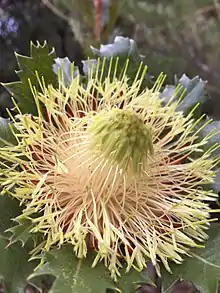Banksia heliantha
Banksia heliantha, commonly known as oak-leaved dryandra,[2] is a species of shrub that is endemic to Western Australia. It has hairy stems, serrated, egg-shaped to wedge-shaped leaves, golden yellow flowers and partly woolly follicles.
| Oak-leaved dryandra | |
|---|---|
 | |
| Banksia heliantha in the ANBG | |
| Scientific classification | |
| Kingdom: | Plantae |
| Clade: | Tracheophytes |
| Clade: | Angiosperms |
| Clade: | Eudicots |
| Order: | Proteales |
| Family: | Proteaceae |
| Genus: | Banksia |
| Subgenus: | Banksia subg. Banksia |
| Series: | Banksia ser. Dryandra |
| Species: | B. heliantha |
| Binomial name | |
| Banksia heliantha | |
| Synonyms[1] | |

Description
Banksia heliantha is a robust, openly-branched shrub that typically grows to a height of 0.6–3 m (2 ft 0 in–9 ft 10 in) and has hairy stems but does not form a lignotuber. The leaves are wedge-shaped to egg-shaped with the narrower end towards the base, 50–90 mm (2.0–3.5 in) long and 22–50 mm (0.87–1.97 in) wide on a petiole up to 10 mm (0.39 in) long. The leaves have between five and fifteen sharply-pointed teeth up to 6 mm (0.24 in) long on each side. The flowers are borne in groups of between 140 and 160 in a head on the ends of branches with hairy, tapering linear involucral bracts up to 50 mm (2.0 in) long at the base of the head. The flowers have a golden yellow perianth is 35–41 mm (1.4–1.6 in) long that is hairy at its base and a yellow pistil 41–52 mm (1.6–2.0 in) long and glabrous. Flowering occurs in March or from July to October and the follicles are egg-shaped, 15–20 mm (0.59–0.79 in) long and woolly in the upper half. Up to fifteen follicle form in each head.[2][3]
Taxonomy and naming
The oak-leaved dryandra was first formally described in 1856 by Carl Meissner who gave it the name Dryandra quercifolia and published the description in de Candolle's Prodromus Systematis Naturalis Regni Vegetabilis from specimens collected by James Drummond.[4][5] The specific epithet (quercifolia) is a Latin word meaning "oak-leaved".[6]:290
In 2007, Austin Mast and Kevin Thiele transferred all the Dryandra species were transferred to Banksia but there was already a different species known as Banksia quercifolia, so the name of this dryandra was changed to Banksia heliantha.[7][8] The epithet (heliantha) is from ancient Greek, meaning "sun-flowered".[6]:215
Distribution and habitat
Banksia heliantha grows in dense kwongan on rocky hills near the south coast of Western Australia between the Gairdner River and East Mount Barren, and inland as far as the ranges north of Ravensthorpe, in the Esperance Plains and Mallee biogeographic regions.[2][3]
Conservation status
This banksia is classified as "not threatened" by the Government of Western Australia Department of Parks and Wildlife.[2]
References
- "Banksia heliantha". Australian Plant Census. Retrieved 2 May 2020.
- "Banksia heliantha". FloraBase. Western Australian Government Department of Parks and Wildlife.
- George, Alex S. (1999). Flora of Australia (PDF). 17B. Canberra: Australian Biological Resources Study, Canberra. pp. 292–293. Retrieved 2 May 2020.
- "Dryandra quercifolia". APNI. Retrieved 2 May 2020.
- Meissner, Carl; de Candolle, Augustin P. (ed.) (1856). Prodromus Systematis Naturalis Vegetabilis. Paris: Sumptibus Victoris Masson. p. 467. Retrieved 2 May 2020.CS1 maint: extra text: authors list (link)
- Francis Aubie Sharr (2019). Western Australian Plant Names and their Meanings. Kardinya, Western Australia: Four Gables Press. ISBN 9780958034180.
- Mast, Austin R.; Thiele, Kevin (2007). "The transfer of Dryandra R.Br. to Banksia L.f. (Proteaceae)". Australian Systematic Botany. 20 (1): 63–71. doi:10.1071/SB06016.
- "Banksia heliantha". APNI. Retrieved 2 May 2020.
- Cavanagh, Tony; Pieroni, Margaret (2006). The Dryandras. Melbourne: Australian Plants Society (SGAP Victoria); Perth: Wildflower Society of Western Australia. ISBN 1-876473-54-1.
| Taxon identifiers |
|---|